So breakfast is said to be the most important meal of the day. The part of the day you should not ignore. Infact, while travelling, we never skip breakfast. Lunch might go a little haywire. Now in this installment of our breakfast series, we bring around a few traditional breakfast items famous in Asia. And this traditional breakfast in Asia has been recommended by travellers who have been there and done that!

Asia is an eclectic mix of various cultures and that can be seen in the food. All the 48 countries have their own cuisine. Even if the dishes and ingredients are similar, each country has some special ingredient or a unique way of preparation that makes it different from the rest.
However, let me state a full disclaimer – these are definitely not all. Infact, I have not been able to cover all the countries of Asia. The list is just indicative and not comprehensive. I wish to keep on adding to this as we travel more and eat even more.
So what are you waiting for. Just dive in! And do not forget to taste these lip-smacking traditional breakfast in Asia when you visit these countries.
Traditional Breakfast in Asia
1. Traditional Pithas of Assam, India
Contributed by Joydeep from the Gypsy Chiring

The essence of Assam’s culture and its food habits surround agriculture. The staple food – Rice is the source of the traditional breakfast snack ‘Pitha’ of the Assamese. The locally found Bora Saul, glutinous rice is mostly used for making the different types of Pithas. While there are many pithas based on their way of preparation, the following are my favourite-
Til Pitha: It is a mixture of mashed sesame seeds and jaggery rolled cylindrically in a layer of ground rice flour.
Narikol Pitha: Similar to Til Pitha, here sugar and grated coconut is used as an inner-filling.
Sunga Pitha: The Sticky rice flour of Bora Saul is cooked in a bamboo tube and eaten with jaggery, curd or curry.
Kolpatot Dia Pitha: The mushy mix of rice flour, banana, sugar, salt and water is neatly wrapped in a banana leaf and cooked on a pan.
Bhugali Bihu (January) and Rongali Bihu (April) are the best time to taste such ethnic delicacies of Assam. “Tholgiri” in Guwahati is an ethnic hub, a store and a restaurant where one can learn about the indigenous cultures, eat delicious ethnic cuisines of Assam and even buy Pithas.
2. Luchi and Sada Aloo Tarkari (potato curry), Kolkata, India

If you have a Bengali friend, you must have heard about Luchi. Afterall, luchi is one of the most popular and loved breakfast items in the Bengali household. As a Bengali myself, I have seen the excitement around Luchi in my house, because you will rarely find a Bengali who does not dote on Luchi.
Luchi is basically the Bengali version of puris. It is a soft, deep fried flatbread made of refined flour. While growing up, we used to have different breakfast everyday. But Sundays were reserved for this special dish. I would see my mother and aunties make the dough in the morning with flour. The dough was then divided into small balls and then rolled into circular sizes. These were then deep fried in hot oil.
Luchis are usually served with curry. Simple potato curry with nigella seeds for tempering is one of my favourite dishes that go with the luchis. Other dishes like Alo Dum, Chola Dal, fried brinjal, chicken or mutton curries are equally popular and loved.
The origin of luchi is not clear, but it finds mention in the medieval literature of Bengal. Perhaps it originated during that time.
Unlike other flatbread items like puri, kachori, kulcha and others, you will generally not find luchis easily in street side stalls. Even if you find one, the taste is nowhere like that in a home. So, if you have a Bengali friend, ask them for a Luchi breakfast.
However, of late, prominent Bengali restaurants have started including Luchis in their menu. You will get luchis in restaurants in Kolkata like Kasturi, 6 Ballygunge Place, Bhojohori Manna that serve Bengali cuisines.
3. Masala Dosa, India
Contributed by Charu from Travel with CG

Dosa is a fermented savory crepe that is traditionally made using a rice and lentil batter. It is a breakfast dish originating from the South of India but is commonly available throughout the country. Many southern Indian states have their own version of the dosa, and it is not easy to tell where exactly it was really invented first. Although claims of it having been created in the temple streets of Udupi, Karnataka are credited.
Masala dosa refers to a specific preparation in which a filling of turmeric spiced potatoes is stuffed inside the crepe. Other variants such as the Rava dosa (made using semolina), Mysore masala dosa (made with a spicy sauce and potatoes), and paneer dosa (cottage cheese filling) are also common to find. Irrespective of their different preparations, dosas are usually accompanied by coconut chutneys and a lentil curry called sambhar.
Since dosas are widely popular in India, one can expect to find them at most hotel breakfasts. Properties such as the Kumarakom Lake Resort in Kerala even serve a made-to-order cone-shaped dosa almost every day. Most South Indian and multi-cuisine restaurants across India usually have them on the all-day menu too.
4. Halwa Puri, Pakistan & Northern India
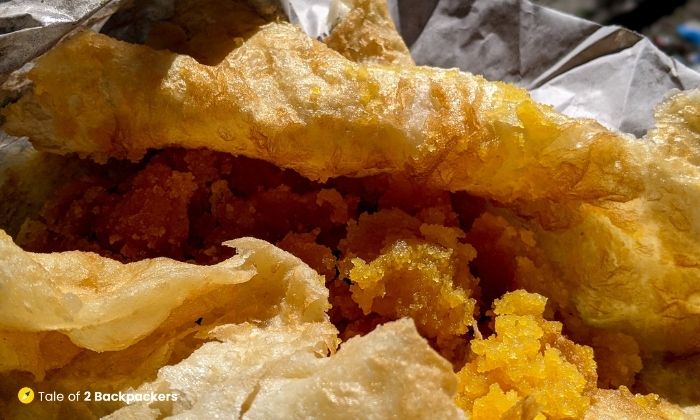
Halwa Puri is a traditional breakfast in Pakistan as well as in parts of India. This popular breakfast platter originates from the Indian subcontinent and usually consists of semolina pudding or halwa and a soft fried dough, puri.
“Halwa” comes from the Arabic word “hulw” meaning sweet. This sweet dish is said to have been imported from Turkey. There are some stories that claim Halwa originated, or at least, was modified, in the kitchens of Suleiman the Magnificent, who ruled the Ottoman Empire from 1520 to 1566. It is believed that halwa arrived in the Indian subcontinent during the Delhi Sultanate, from the early 13th to the mid-16th century.
In Pakistan, halwa, puri and chhole make for great breakfast items. Many shops in Pakistan open at the wee hours of the morning to prepare this iconic item to serve their patrons during breakfast hours.
Halwa is typically made with a mixture of fried semolina and sugar syrup. It is then combined with nuts such as pistachios and almonds and flavoured with cardamom and kewra water. Puri is a soft and fluffy fried bread consisting of a dough made with flour, water, salt, and oil. Chole Masala is a delicious and savoury chickpeas curry served with Halwa puri.
Although this might not be the healthiest option to start your day, you can always cheat one day to have this iconic Pakistani breakfast.
The best places to have Halwa puri are Taj Mahal Sweets and Sadiq Halwa Puri in Lahore, Karachi Sweet Shop and Dhamthal in Karachi.
5. Nihari, Pakistan & India
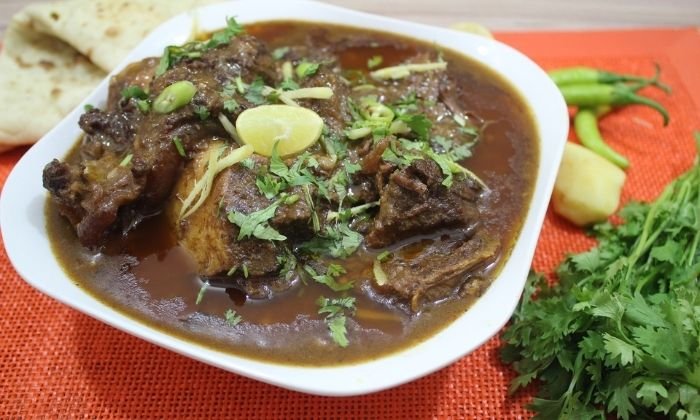
One of the major contributions of the Mughals in the Indian subcontinent is definitely the variety of cuisines it had to offer. One such succulent dish is the Nihari. It is a stew based dish made by slow cooking of meat along with the bone marrow. Prepared with an array of herbs and spices, Nihari is usually served with Naan, a crispy flatbread.
Although Nihari can be consumed all around the year, it is a winter delicacy, especially during the month of Ramadan.
Some historians trace the roots of Nihari to Awadh (erstwhile Lucknow in India) during the Mughal era, it is generally accepted that Nihari was developed in Old Delhi at the time when the kitchens of Delhi Sultanate were thriving with cuisines brought from Persia.
The word “Nihari” comes from the Arabic word “Nahar”, which means morning. Muslim Nawabs (Noblemen) usually ate Nihari after their sunrise prayers (Fajr), after which they would take naps until the afternoon Muslim prayers (Zhuhr). Later it became a regular dish of the working class due to its energy boosting properties.
When Pakistan gained independence in 1947, numerous immigrants from Delhi settled in Karachi, where they established their own restaurants and Nihari became a popular dish in Pakistan.
Nihari is slow cooked overnight in large pots. The meat is cooked together with stock and numerous spices such as cumin, cloves, garam masala, and cardamom in big vessels which are sealed with dough.
Nihari is undoubtedly a popular breakfast food in Pakistan, as well as in Delhi, Kolkata and Dhaka and Chittagong in Bangladesh.
Some of the best places to have Nihari are Zahid Nihari and Javed Nihari in Karachi.
In India, you will get Nihari in shops in Old Delhi and a few shops in Kolkata.
6. String Hoppers, Sri Lanka
Contributed by Luke from Wild About BC

String hoppers, also known as Idiyappam, are an extremely popular breakfast food that is usually served with some form of curry and/or sambol. They are made up of thin strings of rice noodles that are steamed together in small bundles to make what looks like a stringy pancake. Sri Lanka grows over 14 different types of rice and rice is a common staple in most Sri Lankan food.
String hoppers are made by mixing red or white roasted rice flour with water to make a dough and then it is pressed through a sieve or a special press to make the strands. These bundles of strings are then steamed together to make the pancake shaped discs that are served for breakfast.
The dish originated in South India in the 1st century AD before moving over to Sri Lanka where there is a heavy influence from this region. This dish is sometimes eaten for other meals but is most commonly served as a traditional breakfast. A great place to try string hoppers is the Garden View restaurant in the mountain town of Ella.
7. Kiribath (Milk Rice), Sri Lanka
Contributed by Sasha from Mog and Dog Travels

One of Sri Lanka’s most iconic and delicious breakfast dishes is kiribath or milk rice. Despite its name, kiribath does not actually contain milk (just coconut milk) and is one of the many Sri Lankan dishes that are suitable for vegans and vegetarians.
Sri Lankan households traditionally used to prepare kiribath to celebrate special occasions. The dish symbolises all sorts of new beginnings: for instance, you will always find kiribath on the table during New Year celebrations and at weddings, the groom will traditionally feed a piece of kiribath to his bride. Kiribath is also usually the first solid food given to babies in Sri Lanka.
Nowadays, kiribath is considered to be a traditional Sri Lankan breakfast dish and can be found in most restaurants all over Sri Lanka. Whilst the recipe is fairly simple – white rice is cooked with thick coconut milk, pandan leaves and salt – the presentation of kiribath is key too! Once ready, the rice is transferred into a shallow dish and then flattened with a spatula or spoon. When cooled, it is then cut into square or diamond-shaped pieces.
Kiribath is usually served with a spicy Sri Lankan condiment (also known as a sambol) called luni miris. Made from dried red chillies pounded together with red onions, lemon juice and salt, this extremely spicy relish is the perfect accompaniment to the creamy coconutty goodness of kiribath.
8. Silog, the Philippines
Contributed by JB from Will Fly for Food

Ask any Filipino what their favorite breakfast dish is, and many will tell you it’s silog. Silog refers to a family of Filipino breakfast dishes consisting of garlic fried rice, a fried egg, and some type of meat. You can think of it as the Filipino version of nasi lemak.
There are many different versions of silog and each version gets its name from the type of meat used to make it. For example, one of the most popular types of silog is called longsilog. Longsilog is a portmanteau word for longganisa (Filipino sausage) with sinangag (garlic fried rice) and itlog (fried egg). The main protein can change but every silog dish will always have garlic rice and a fried egg.
Longsilog, tapsilog (grilled cured beef), and tocilog (sweetened and cured pork belly) are by far the most popular types of silog but it can be made with many different meats and proteins like SPAM (spamsilog), bacon (bacsilog), bangus (bangsilog), corned beef (cornsilog), and hot dog (hotsilog). It’s usually eaten with a vinegar-based dipping sauce and sometimes served with other side dishes as well like fresh tomatoes and pickled shreds of papaya.
Silog is traditionally a breakfast dish but it can be enjoyed at any time of the day. It’s available at virtually every Filipino restaurant and hotel that serves breakfast in the Philippines.
9. Shakshuka, Israel
Contributed by Milijana Gabrić from World Travel Connector
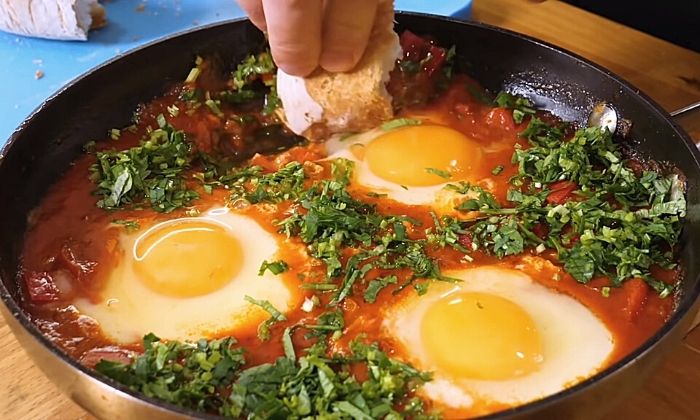
Foods from Israel are well-known as some of the most delicious, healthiest, and most vegetarian-friendly food in the world. The same applies to the famous Israeli breakfast Shakshuka.
Flavourful Shakshuka is the most popular breakfast dish in Israel. Classic Israeli Shakshuka is a simple but absolutely tasty dish, made of eggs poached in a spicy tomato and pepper sauce garnished with paprika, onions, chilies, cumin, and coriander. Shakshuka, a breakfast staple, is typically eaten with challah or pita bread.
While it originates from Northern Africa and is a popular dish across the Middle East and the Maghreb, the country where Shakshuka has been brought to perfection is Israel. Maghreb Jews brought Shakshuka to Israel, modified it a bit to make it ‘pareve’ and over time it has become widely accepted in Israel. Moreover, tremendously aromatic and moderately spicy Shakshuka has become a signature breakfast dish of Israel and is passionately eaten in Israeli homes and at restaurants in Israel.

So, when traveling to Israel, don’t miss trying authentic Israeli Shakshuka. If you are traveling to Jerusalem, head to the famous Mahane Yehuda Market and order delicious Shakshuka in a traditional restaurant at the market.
Most likely, Shakshuka will become your next favorite breakfast dish and you will grab an authentic Shakshuka recipe as your dearest souvenir from Israel.
10. Khao piak sen, Laos
Contributed by Marie from A Life without Borders

Eaten daily for breakfast, khao piak sen is the traditional chicken noodle soup of Laos. This hearty Lao street food is regarded as an essential comfort food, often made in huge batches to feed the whole family.
Consisting of wafer-thin slices of meat floating in a clear chicken or pork broth, khao piak sen gets its flavour from the abundance of fragrant Asian herbs and chilli. However what makes this soup distinctive is its rice noodles.
Literally translated as “wet rice strands”, the fresh noodles (somewhat resembling Japanese udon), are made fresh daily from a blend of rice and tapioca flours. With a slightly chewy texture, the starchy noodles give a lovely thickness to the simple soup.
Khao piak sen is traditionally accompanied by an abundance of salad vegetables and fresh herbs including lettuce, cabbage, bean sprouts, beans, mint, basil and coriander – all topped with slices of fiery red chilli and lime wedges. The piping-hot soup is then tailored to the individual with the addition of condiments such as fish sauce, soy sauce, pickled vegetables and a pungent-smelling shrimp paste.
Eaten year round, khao piak sen is available throughout Laos. You can find this renowned breakfast food at Xieng Thong Noodle in Luang Prabang.
11. Indonesian Nasi Goreng
Contributed by By Mal from Raw Mal Roams

Nasi goreng, which means fried rice, is one of six official national dishes of Indonesia. Nasi goreng is also popular in Malaysia, Singapore, Brunei, Sri Lanka and the Netherlands because of its colonial past.
There is no single recipe for Indonesian fried rice. How the dish is prepared varies from family to family and across different regions. It is, however, very different from other rice-based dishes popular in South East Asia. It has a unique smoky aroma and caramelised savoury flavour achieved by adding sweet soya sauce. It comes with vegetables, sometimes meat and a fried egg, fresh cucumber or crackers on the side. All ingredients are fried with chilli, garlic and onion. In Indonesia, nasi goreng is also popular in a vegetarian version with a side of tempeh in place of meat.
Nasi goreng can be found almost everywhere, and it is a popular choice for breakfast. You can eat it in 5-star restaurants and cafés in Bali. However, for the most authentic experience, find a local eatery called ‘warung’ on the side of the main street in any Indonesian town and have your nasi goreng the way local people eat it daily.
12. Traditional Japanese breakfast served in Ryokan
Contributed by Alyse from The Invisible Tourist

When planning a Japan itinerary, one should certainly include a stay in a ryokan – a traditional family-run Japanese inn. Located in many destinations around the country, ryokan are great examples of exceptional Japanese hospitality. Some of the best locations to stay are in well-preserved cities such as Takayama or Kyoto.
Breakfast is included with a ryokan stay, each guest served immaculately presented trays comprising multiple small dishes. Each dish can take on the appearance of a miniature artwork, as presentation and attention to detail is very highly regarded in Japanese culture.
A typical Japanese breakfast usually consists of miso soup, tofu, dehydrated egg yolk, mackerel (salty fish), pickled vegetables and boiled white rice. To finish on something sweet, fruits such as red grapes and oranges accompany savoury items.
The one Japanese breakfast item that mostly divides visitors to Japan is natto – fermented, sticky soy beans served in a small plastic cup. This pungent-smelling delicacy is thought to have many benefits to improve health, although some may argue its stringy texture may be too much to stomach first thing in the morning!
13. Traditional Malaysian Breakfast, Malaysia
Contributed by Victoria from Guide Your Travel

A traditional Malaysian breakfast is generally savoury and involves white rice and some sort of sauce. Nasi Lemak is an especially popular dish that is commonly served in the mornings but also for lunch or dinner. It involves coconut infused rice, egg, peanuts, anchovies and a delicious sauce. It might not be your first thought to have anchovies for breakfast but this is a truly delicious dish you need to try at least once.
Malaysia is a melting pot of cultures with lots of influence from Chinese and Indian cuisines. A great Indian-Malaysian breakfast dish is Roti Canai. This is a special flatbread served with dal or kari ikan which is a fish curry. It’s commonly eaten with your hands and an important meal in Malaysian street food cuisine.
A lot of people will pick up breakfast on their way to work or buy a packed lunch somewhere. Kuala Lumpur and its popular neighbourhood KLCC is one of the best places in Malaysia to try different breakfast dishes and delicious specialties. With so many options to choose from you’ll fall in love with Malaysia and its delicious breakfast foods.
14. Pho, Vietnam
Contributed by Jessica from Uprooted Traveler
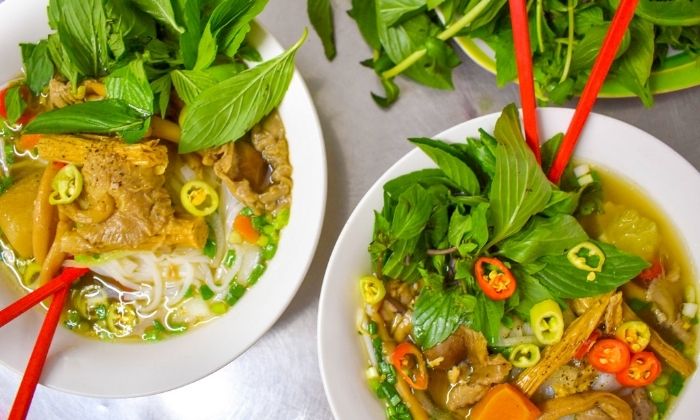
Pho is a beloved Vietnamese soup, consisting of savory broth, rice noodles, herbs, and a protein, which may range from beef to tofu. This tasty meal originated in northern Vietnam in the early 20th century and later spread in popularity globally by refugees after the Vietnam War in the 1960s.
While pho has admirers around the world, those outside of Vietnam traditionally miss one aspect of the dish- it’s frequently enjoyed for breakfast! If you walk down any bustling city street in Vietnam on any given morning, you’ll find stalls and stoops, where purveyors lovingly ladle heaps of pho into comically large bowls. The patrons, oftentimes hunched over their pho as they sit on tiny plastic stools, will slurp down their bowl on their way to work.
Why only Asia? Head over to this article to learn about some traditional breakfasts around the world.
Another benefit of enjoying a steaming bowl of pho in Vietnam- it usually costs less than $1. If you’re looking for an amazing bowl of pho, Phở Chay Như in Ho Chi Minh City is an excellent place to stop- the broth is incredibly flavorful, the portions are hearty, and there’s all the chilis your heart (and stomach) could desire!
15. Turkish Menemen
Contributed by Polly from Polly Goes
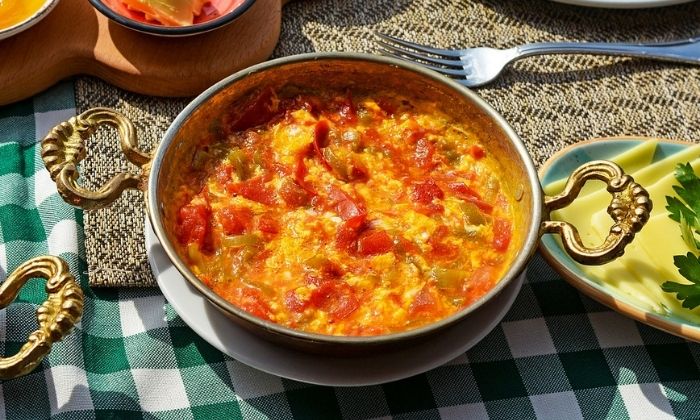
A typical Turkish breakfast can be quite simple, made up of some bread, cheese, olives and chopped cucumber and tomato. A traditional Kahvalti can also end up being a much more elaborate spread, with sliced meats, clotted cream and honey, fruits and berries, and eggs. Not just plain scrambled or fried eggs like you might find in many other places around the world, however.
Turkish breakfast egg dishes go an extra mile in terms of flavor, and perhaps the most common and one of the most popular egg dishes you’ll find on a menu – or whipped up in a Turkish family’s home – is menemen. The name menemen comes from an area of Turkey near the city of Izmir.
The main components of traditional menemen are eggs, tomatoes and peppers, and usually onions and some herbs. The key feature that makes menemen unique is the ratio of eggs to other ingredients – about equal in volume – and cooking the eggs so they are soft scrambled. Istanbul’s Van Kahvalti Evi is a favorite place among both locals and visitors for menemen and other delicious Turkish breakfast menu items.
16. Non, Uzbekistan
Contributed by Sarah Steiner from Away with the Steiner
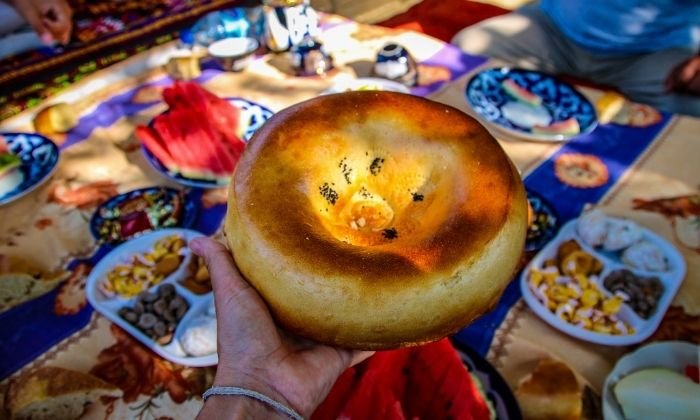
There is a local Uzbek proverb saying – “Respect for Non is respect for country”. Such is the importance of Non in Uzbek life. Uzbek Non finds mention in writings and poems from 2700 BC!
Sharing bread has been an integral part of hospitality traditions of the region. Uzbek non is put beneath the head of a newborn child, with the hope that the child will have a long life. Non is also placed between the legs of a toddler just learning to walk, so that the child leads a blessed life.
Uzbek bread is made of simple or fat dough. Sometimes, ingredients like milk, sour cream, eggs and herbs are also added. Earlier, remains of dough from a previous batch of bread were used for fermentation instead of yeast. Classic Uzbek bread is baked in a tandir oven (traditional Central Asian clay oven), also known as tandoor.
Cities of Uzbekistan each make their non slightly differently with bread from Samarkand being the most revered. Samarkand bread is believed to remain edible for up to three years!
Make the most of breakfast in Uzbekistan by trying everything that is on offer. It is truly one of the most memorable breakfasts of Asia!
17. Manakish, Lebanon
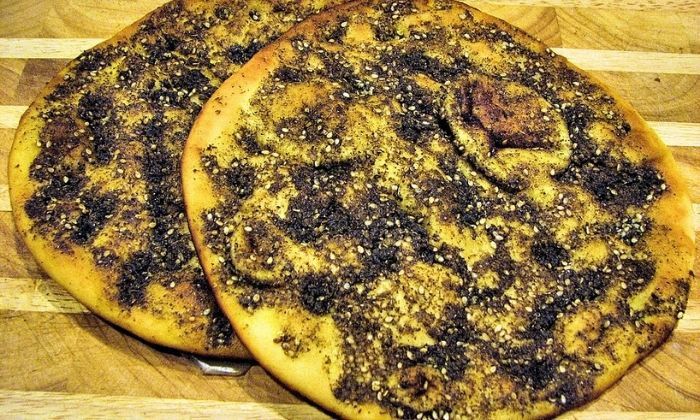
This is perhaps the most favourite Lebanese breakfast item and definitely not to be missed when you visit Lebanon. Manakish is a round flatbread, typically topped with olive oil and zaatar (sesame seeds, thyme and sumac) and then baked in a dome-shaped or flat oven. Other toppings may include minced lamb, cheese, spinach or fried aubergines. Sounds something like a pizza, right? Well, it is affectionately known as the Lebanese Pizza!
Manakish is also known as “Manoush”, “Manaeesh” or Manakeesh. Manoush came from the Arabic word “Manqushah”, which means “carve-out” or to stamp or decorate. This refers to the indentations made with fingers while flattening the dough for the toppings.
Traditionally, Arab women used to bake the dough in a communal oven in the morning, to provide their family with their daily bread needs, and would prepare smaller portions of dough with different toppings for breakfast.
Manakish has become one of the most popular dishes of Lebanon due to its flavours, ease of preparation and low price. Do not miss this Lebanese pizza on your visit to Lebanon.
18. Gudeg, Yogyakarta, Indonesia

“The Famous Wijilan Gudeg” by ^riza^ is licensed under CC BY 2.0
Gudeg is one of the most popular dishes in Yogyakarta in Indonesia. Known as the sweet jackfruit stew of Yogyakarta, Gudeg is a unique dish made from young unripe jackfruit known as ‘gori’ and coconut milk.
The jackfruit is shredded and boiled with palm sugar and coconut milk over low heat for several hours. Garlic, shallot, candlenut, coriander seed, galangal, bay leaves and teak leaves are added to the mix. The teak leaves give the reddish brown color to the dish. Gudeg tastes best when cooked in an earthen pot over wooden or charcoal fire. The taste is dominantly sweet, but also has a tinge of spiciness.
Gudeg is usually served with rice, sambel goreng krecek (crisp beef skins fried with chilli and peanuts), opor ayam (a sort of chicken curry drenched in coconut milk), telur pindang (seasoned boiled egg), and tahu or tempe bacem (sweet steamed tofu or soybean cake).
Gudeg can be found in almost every part of Yogyakarta; however the most popular place for Gudeg is at Wijilan and Barek.
19. Baozi, China

Baozi or simply Bao is one of the most favourite breakfast food in China. This filling and lip-smacking dish is actually a steamed bun made with mantou bread and stuffed with a variety of fillings, ranging from sweet to savoury. Typical fillings include various meats, seafood and vegetables.
The buns are steamed on giant bamboo platters and are stacked on top of each other. These are usually served in their own individual steaming basket, with a straw used to drink the soup while the rest of the bun is eaten later.
It is believed that Baozi was invented by Zhuge Liang, a military strategist, during the Three Kingdoms period in the third century. He saw his soldiers suffering from plague and devised this food item as a symbolic offering to the gods and was then given to the soldiers to alleviate their suffering.
In China, Baozi is found in every corner. You will see the vendors preparing the dish using bamboo baskets and selling them to the patrons. Baozi are also served in the restaurants as well. Although Bao is traditionally steamed, you will also find baked and pan-fried variety.
So that was quite a list. Being from Asia, I have had the opportunity to have a few of these delectable cuisines. Truly, most of these food are quite related to the culture and lifestyle of the place.
So what is your favourite Asian breakfast? Let us know in comments below. Also, share with us the most bizarre food that you have eaten. For me, it was rat roast in Basar, Arunachal Pradesh.
Please share this post with your family, friends and neighbours. After all, sharing is caring.
Pin it for a later read!



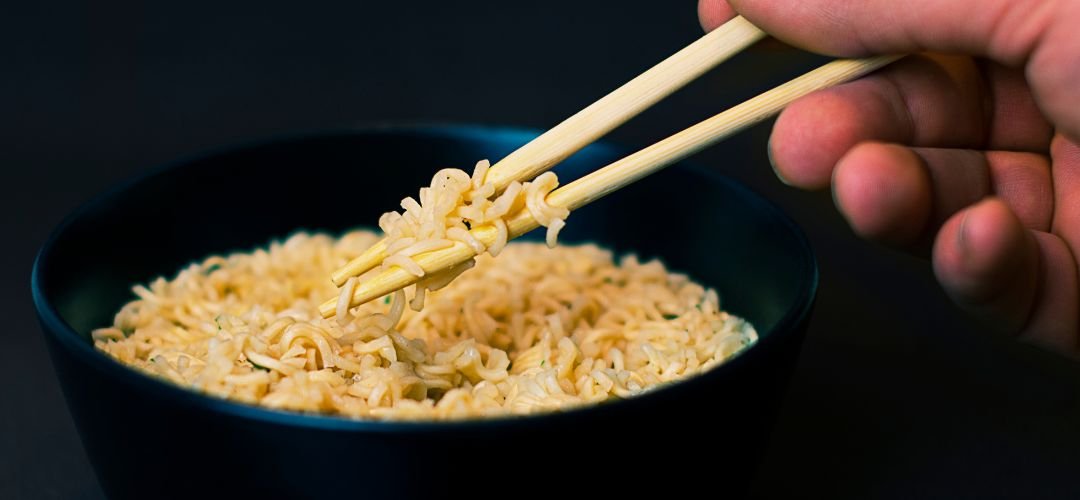




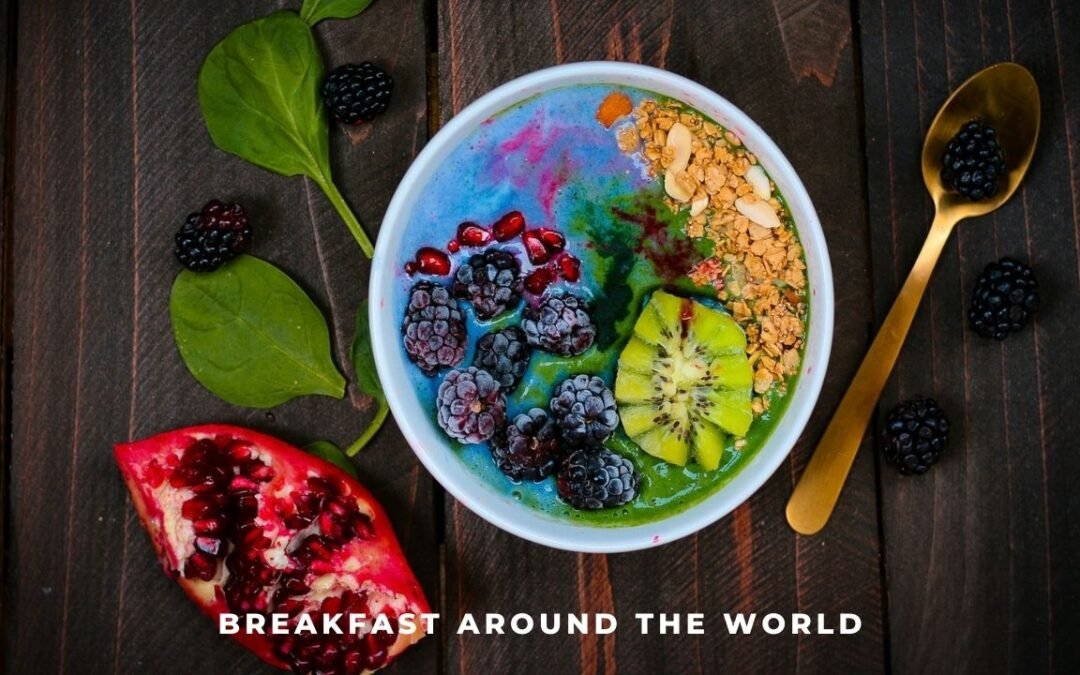




Luchi and Masala dosa are my favourites apart from the traditional Pithas. Reading about the dishes from other parts of Asia is making me want to taste them soon. Definitely trying it out whenever I get the opportunity.
Thank you Joydeep! And we love Pithas as well!
That thing baozi is called Momo’s in India and most people in India are crazy for this dish.
Yes, that’s true!